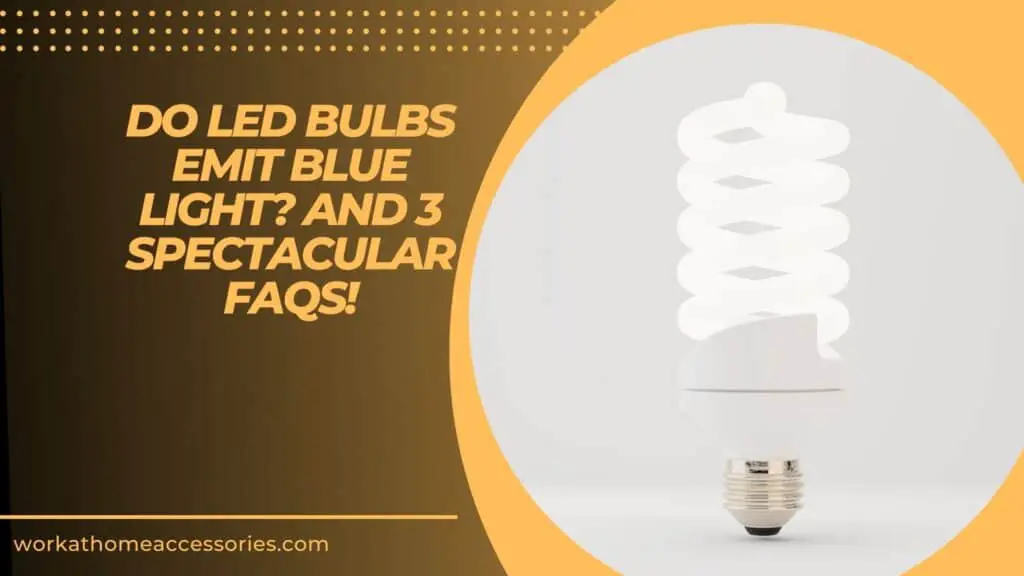People are becoming increasingly aware of the impact that blue light can have on our sleep and our health. Consequently, there’s a growing interest in reducing exposure to blue light. With that in mind, this article investigates common FAQs about blue light including questions such as do LED bulbs emit blue light? Let’s find out!
If you’re in a hurry, here is a site I recommended for office equipment with lifetime guarantee!
Do LED bulbs emit blue light?
All white LED bulbs emit a blue light, otherwise if the blue light was omitted, they would be an orange-colored LED bulb. The amount of blue light that LEDs contains varies depending on the color of the LED bulb. Blue-colored LED bulbs emit a large volume of blue light. Cooler white LED bulbs contain a larger amount of blue light than a warmer white LED bulb. The color temperature on the box indicates the amount of blue light present. The greater the light temperature, the greater the amount of blue light present. Temperatures which range around 2700K tend to be more yellow than blue, while temperatures of around 4000K or more contain higher volumes of blue light. Newer LED bulbs contain lower amounts of blue light
It’s clear that there are many aspects to be considered when choosing lighting. If blue light exposure is a concern for you and you want to reduce eye strain, certain factors should be considered when choosing a light bulb. Read on to find out which light bulbs contain the lowest amount of blue light.
When compared to artificial lighting, a study revealed that working in an office with natural lighting can reduce eyestrain by 51% as well as improving your quality of sleep. Source

Do lightbulbs emit blue light?
In general, practically all lightbulbs emit at least some degree of blue light. This includes incandescent light bulbs, fluorescent light bulbs and LED light bulbs.
The level of blue light present is attributed more to the color of the light than the type of light bulb itself. However, the type of lightbulb will also influence the quantity of blue light emitted.
Related: Is It Bad To Have An Office With No Window? Expert Facts!
If the blue light is removed from any source of white light, it will no longer be white. Instead, it will become a distinct yellow color.
Incandescent light bulbs tend to emit lower levels of blue light than LED lights.
However, since incandescent light bulbs are considered inefficient, they are being phased out for more energy-efficient LED bulbs.
CFLs (Compact Fluorescent Lights) which have a warm light are also a suitable option for those of you seeking lights with lower blue light levels.
Lights with a lower color temperature contain less blue light than lights that contain a higher color temperature.
Bulbs rated with a color temperature around 2700K are considered to have low levels of blue light.
The average light bulb tends to have a color temperature value of 4000K or more.
Some lighting experts recommend a color temperature of around 5000K in offices to promote productivity.
Tip: Since blue light disturbs sleep patterns, use warm white bulbs in areas where you will be before going to sleep
Related: How To Reduce Light Glare In Office? Clever Tips & FAQs!
What light bulbs don’t emit blue light?
Generally, light bulbs which have a red or green color tend to emit little to no blue light. Additionally, light bulbs which emit very little to no blue light include LED incandescent bug lite bulbs, blue blocking light bulbs and low-pressure sodium lights.
To minimize the amount of blue light emitted, opt for light with a lower color temperature.
Low blue light bulbs are also available which are generally designed for use in bedrooms to help people to sleep.
For bedrooms, lights with a color temperature less than 3000K are best to minimize the amount of blue light present.
To encourage productivity, alertness and for areas which require high visibility, a cold white colored light (daylight color) around 5700K is recommended.
Recommended product: LED light, flicker-free, dimmable + lifetime warranty
Does sunlight emit blue light?
Sunlight is a primary source of natural blue light. Approximately 25% of sunlight is blue light. The actual amount of blue light present in the sky depends on factors including the time of day, the latitude that you are located in and the current season. While outdoors, this is when people are exposed to the largest amount of blue light. However, blue light is also present in electronic devices and light bulbs.
To put into perspective where sunlight sits on the color temperature chart:
- Candlelight = 1800K
- Extra warm white light = 2800K
- Cool white office light = 4000K
- Blue sky = 8000 – 12000K
The age-old question of, “why is the sky blue?”, comes to mind here. Sunlight contains high energy blue wavelengths. This blue light is scattered in all direction by tiny molecules.
Since blue light is shorter and smaller waves, it’s scattered more than the other colors.
Consequently, this is why we see a blue colored sky most of the time.
Related: Should I Put Desk In Front Of Window? You Need To Know Why
Conclusion
It’s evident that LED bulbs contain blue light, but they are not the only culprit. From mobile phones to tablets, light bulbs and even the sun outside, there’s no escaping blue light.
Unfortunately, since LEDs are replacing incandescent lights, our choice of bulbs with low blue light is becoming increasingly difficult.
While we can’t eliminate our exposure to blue light, we can make smart decisions to reduce the volume of blue light that we are exposed to.
Warm white LEDs are the better option that cool blue or blue LEDs to minimize sleep disruption as they contain lower levels of blue light.
Here are some other useful articles I wrote that you should go check out:
- Top 5 Smart Plug FAQs – Avoid Simple Mistakes!
- Essential work at home gadgets – 5 must-haves!
- How To Choose A Smart Plug – 9 Must Know Factors!
- Smart Plug Pros And Cons – 11 Must Know Helpful Factors!
- Smart Plug V Timer – Plus The Best Buy For You!
Recommended products:
- Kasa Smart Plug Works with Alexa, Echo, Google Home (link on Amazon)
- Kasa Smart Light Bulbs (link on Amazon)
- Kasa Smart Plug Power Strip (link on Amazon)

